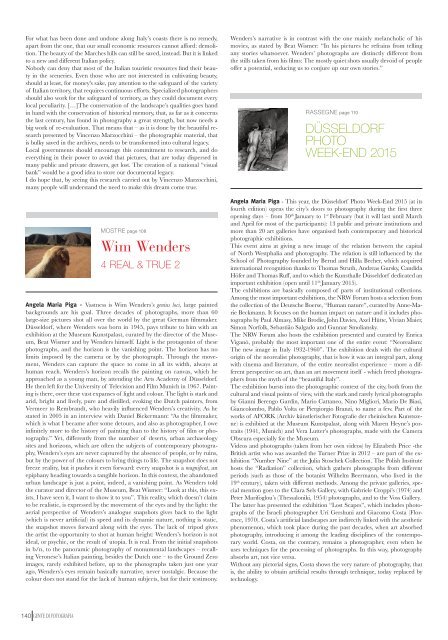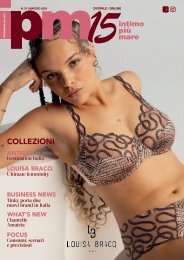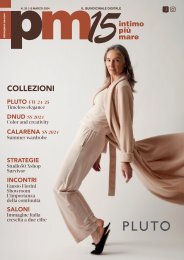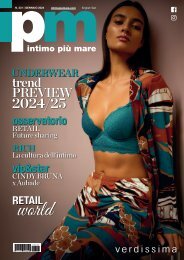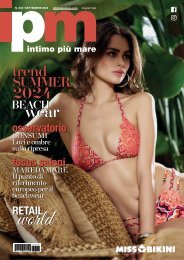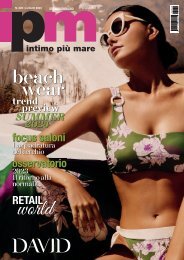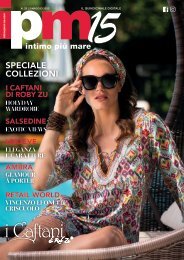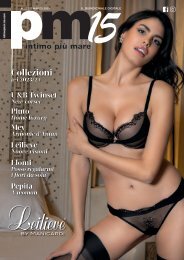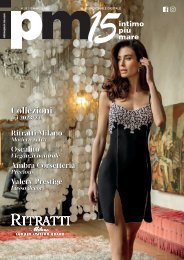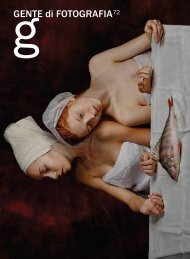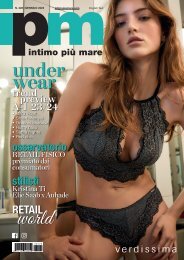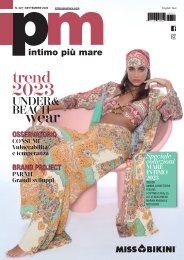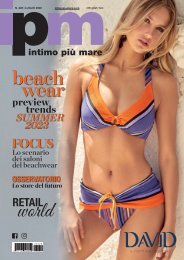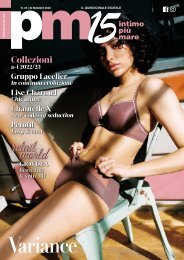Gente di Fotografia n°61
You also want an ePaper? Increase the reach of your titles
YUMPU automatically turns print PDFs into web optimized ePapers that Google loves.
For what has been done and undone along Italy’s coasts there is no remedy,<br />
apart from the one, that our small economic resources cannot afford: demolition.<br />
The beauty of the Marches hills can still be saved, instead. But it is linked<br />
to a new and <strong>di</strong>fferent Italian policy.<br />
Nobody can deny that most of the Italian touristic resources find their beauty<br />
in the sceneries. Even those who are not interested in cultivating beauty,<br />
should at least, for money's sake, pay attention to the safeguard of the variety<br />
of Italian territory, that requires continuous efforts. Specialized photographers<br />
should also work for the safeguard of territory, as they could document every<br />
local peculiarity. […]The conservation of the landscape’s qualities goes hand<br />
in hand with the conservation of historical memory, that, as far as it concerns<br />
the last century, has found in photography a great strength, but now needs a<br />
big work of re-evaluation. That means that – as it is done by the beautiful research<br />
presented by Vincenzo Marzocchini – the photographic material, that<br />
is bulky saved in the archives, needs to be transformed into cultural legacy.<br />
Local governments should encourage this commitment to research, and do<br />
everything in their power to avoid that pictures, that are today <strong>di</strong>spersed in<br />
many public and private drawers, get lost. The creation of a national “visual<br />
bank” would be a good idea to store our documental legacy.<br />
I do hope that, by seeing this research carried out by Vincenzo Marzocchini,<br />
many people will understand the need to make this dream come true.<br />
mostre page 108<br />
Wim Wenders<br />
4 Real & True 2<br />
Angela Maria Piga - Vastness is Wim Wenders’s genius loci, large painted<br />
backgrounds are his goal. Three decades of photographs, more than 60<br />
large-size pictures shot all over the world by the great German filmmaker.<br />
Düsseldorf, where Wenders was born in 1945, pays tribute to him with an<br />
exhibition at the Museum Kunstpalast, curated by the <strong>di</strong>rector of the Museum,<br />
Beat Wismer and by Wenders himself. Light is the protagonist of these<br />
photographs, and the horizon is the vanishing point. The horizon has no<br />
limits imposed by the camera or by the photograph. Through the movement,<br />
Wenders can capture the space to come in all its width, always at<br />
human reach. Wenders’s horizon recalls the painting on canvas, which he<br />
approached as a young man, by atten<strong>di</strong>ng the Arts Academy of Düsseldorf.<br />
He then left for the University of Television and Film Munich in 1967. Painting<br />
is there, over these vast expanses of light and colour. The light is stark and<br />
arid, bright and lively, pure and <strong>di</strong>stilled, evoking the Dutch painters, from<br />
Vermeer to Rembrandt, who heavily influenced Wenders’s creativity. As he<br />
stated in 2005 in an interview with Daniel Bickermann: “As the filmmaker,<br />
which is what I became after some detours, and also as photographer, I owe<br />
infinitely more to the history of painting than to the history of film or photography.”<br />
Yet, <strong>di</strong>fferently from the number of deserts, urban archaeology<br />
sites and horizons, which are often the subjects of contemporary photography,<br />
Wenders’s eyes are never captured by the absence of people, or by ruins,<br />
but by the power of the colours to bring things to life. The snapshot does not<br />
freeze reality, but it pushes it even forward: every snapshot is a magnificat, an<br />
epiphany hea<strong>di</strong>ng towards a tangible horizon. In this context, the abandoned<br />
urban landscape is just a point, indeed, a vanishing point. As Wenders told<br />
the curator and <strong>di</strong>rector of the Museum, Beat Wismer: “Look at this, this exists,<br />
I have seen it, I want to show it to you”. This reality, which doesn’t claim<br />
to be realistic, is expressed by the movement of the eyes and by the light: the<br />
aerial perspective of Wenders’s analogue snapshots gives back to the light<br />
(which is never artificial) its speed and its dynamic nature, nothing is static,<br />
the snapshot moves forward along with the eyes. The lack of tripod gives<br />
the artist the opportunity to shot at human height: Wenders’s horizon is not<br />
ideal, or psychic, or the result of utopia. It is real. From the initial snapshots<br />
in b/n, to the panoramic photography of monumental landscapes – recalling<br />
Veronese’s Italian painting, besides the Dutch one – to the Ground Zero<br />
images, rarely exhibited before, up to the photographs taken just one year<br />
ago, Wenders’s eyes remain basically narrative, never nostalgic. Because the<br />
colour does not stand for the lack of human subjects, but for their testimony.<br />
Wenders’s narrative is in contrast with the one mainly melancholic of his<br />
movies, as stated by Beat Wismer: “In his pictures he refrains from telling<br />
any stories whatsoever. Wenders’ photographs are <strong>di</strong>stinctly <strong>di</strong>fferent from<br />
the stills taken from his films: The mostly quiet shots usually devoid of people<br />
offer a potential, seducing us to conjure up our own stories.”<br />
Rassegne page 110<br />
Düsseldorf<br />
Photo<br />
Week-End 2015<br />
Angela Maria Piga - This year, the Düsseldorf Photo Week-End 2015 (at its<br />
fourth e<strong>di</strong>tion) opens the city’s doors to photography during the first three<br />
opening days – from 30 th January to 1 st February (but it will last until March<br />
and April for most of the participants): 13 public and private institutions and<br />
more than 20 art galleries have organised both contemporary and historical<br />
photographic exhibitions.<br />
This event aims at giving a new image of the relation between the capital<br />
of North Westphalia and photography. The relation is still influenced by the<br />
School of Photography founded by Bernd and Hilla Becher, which acquired<br />
international recognition thanks to Thomas Struth, Andreas Gursky, Can<strong>di</strong>da<br />
Höfer and Thomas Ruff, and to which the Kunsthalle Düsseldorf de<strong>di</strong>cated an<br />
important exhibition (open until 11 th January 2015).<br />
The exhibitions are basically composed of parts of institutional collections.<br />
Among the most important exhibitions, the NRW Forum hosts a selection from<br />
the collection of the Deutsche Boerse, “Human nature”, curated by Anne-Marie<br />
Beckmann. It focuses on the human impact on nature and it includes photographs<br />
by Paul Almasy, Mike Bro<strong>di</strong>e, John Davies, Axel Hütte, Vivian Maier,<br />
Simon Norfolk, Sebastião Salgado and Gunnar Smoliansky.<br />
The NRW Forum also hosts the exhibition presented and curated by Enrica<br />
Viganò, probably the most important one of the entire event: “Neorealism:<br />
The new image in Italy 1932-1960”. The exhibition deals with the cultural<br />
origin of the neorealist photography, that is how it was an integral part, along<br />
with cinema and literature, of the entire neorealist experience – more a <strong>di</strong>fferent<br />
perspective on art, than an art movement itself - which freed photographers<br />
from the myth of the “beautiful Italy”.<br />
The exhibition bursts into the photographic context of the city, both from the<br />
cultural and visual points of view, with the stark and rarely lyrical photographs<br />
by Gianni Berengo Gar<strong>di</strong>n, Mario Cattaneo, Nino Migliori, Mario De Biasi,<br />
Giancolombo, Pablo Volta or Piergiorgio Branzi, to name a few. Part of the<br />
works of AFORK (Archiv künstlerischer Fotografie der rheinischen Kunstszene)<br />
is exhibited at the Museum Kunstpalast, along with Maren Heyne’s portraits<br />
(1941, Munich) and Vera Lutter’s photographs, made with the Camera<br />
Obscura especially for the Museum.<br />
Videos and photographs (taken from her own videos) by Elizabeth Price -the<br />
British artist who was awarded the Turner Prize in 2012 – are part of the exhibition<br />
“Number Nine” at the Julia Stoschek Collection. The Polish Institute<br />
hosts the “Ra<strong>di</strong>ation” collection, which gathers photographs from <strong>di</strong>fferent<br />
periods (such as those of the botanist Wilhelm Beermann, who lived in the<br />
19 th century), taken with <strong>di</strong>fferent methods. Among the private galleries, special<br />
mention goes to the Clara Sels Gallery, with Gabriele Croppi’s (1974) and<br />
Peter Marifoglou’s (Thessaloniki, 1954) photographs, and to the Voss Gallery.<br />
The latter has presented the exhibition “Lost Scapes”, which includes photographs<br />
of the Israeli photographer Uri Gershuni and Giacomo Costa (Florence,<br />
1970). Costa’s artificial landscapes are in<strong>di</strong>rectly linked with the aesthetic<br />
phenomenon, which took place during the past decades, when art absorbed<br />
photography, introducing it among the lea<strong>di</strong>ng <strong>di</strong>sciplines of the contemporary<br />
world. Costa, on the contrary, remains a photographer, even when he<br />
uses techniques for the processing of photographs. In this way, photography<br />
absorbs art, not vice versa.<br />
Without any pictorial signs, Costa shows the very nature of photography, that<br />
is, the ability to obtain artificial results through technique, today replaced by<br />
technology.<br />
140


